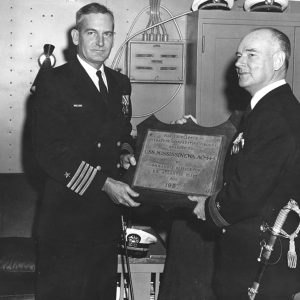calsfoundation@cals.org
Ira Hudson Nunn (1901–1990)
Ira Hudson Nunn was a U.S. Navy officer who was much decorated for his World War II actions, later serving as the Navy’s Judge Advocate General.
Ira Hudson Nunn was born in Camden (Ouachita County) on March 16, 1901, to merchant James B. Nunn and Henrietta Hudson Nunn; he was a descendant of some of the earliest white settlers of the area. Nunn entered the U.S. Naval Academy at Annapolis, Maryland, in 1920 after attending the Marion Military Institute at Marion, Alabama. He graduated from the academy on June 4, 1924, with the rank of ensign.
Nunn married Esther Wagner of Washington DC. They had one daughter.
Nunn served in the U.S. Navy’s Ordnance Bureau in Washington DC immediately after graduation, then saw duty on the battleship USS Texas and the destroyer USS Sharkey before going to the Naval Torpedo Station at Newport, Rhode Island, for torpedo training. Between July 1926 and May 1931 Nunn served aboard the battleship USS New Mexico and destroyers USS Sloat and Upshur.
He was assigned to the navy’s Office of the Judge Advocate General in June 1931, then went to the law school at Harvard University, receiving his Bachelor of Laws degree in 1934. Nunn then was assigned to patrol duty on the Yangtze River in China aboard the gunboats USS Monocacy and Tutuila before serving aboard the cruiser USS Augusta, the flagship of the Asiatic Fleet. His tour of duty in China concluded in May 1937.
Following service in the Judge Advocate General’s office, Nunn saw duty as aide and flag secretary to the commanders of Cruiser Divisions 4 and 5, both aboard the cruiser USS Northampton, prior to similar duty with Commander Cruiser, Scouting Force from February 1941 to April 1942. He then served as an aide to the Navy’s Vice Chief of Naval Operations until September 1943, when he took command of Destroyer Division 2; he was promoted to captain on June 1, 1943. It was during his command of Destroyer Squadron 47, with added service as commander of Destroyer Division 54, between March 1944 and June 1945 that he saw extensive and award-winning combat in operations around Pearl Harbor, Salamaua, Tarawa, Kwajalein, Eniwetok, Emirau, the Solomon Islands, the Marianas, Peleliu, Leyte, Luzon, Iwo Jima, and Okinawa.
Nunn was awarded the Navy Cross “for extraordinary heroism and distinguished service” during the invasion of Leyte in the Philippine Islands between October 18 and 29, 1944. The citation states that “while under repeated attack from Japanese aircraft and suicide dive bombers and while continually in submarine infested waters, Captain Nunn displayed extreme courage, determination, and outstanding leadership in pressing home successful attacks against enemy vessels and aircraft.”
Nunn received a Bronze Star for his actions around Okinawa between March 14 and May 14, 1945, when he “expertly deployed his ships for maximum strength during carrier operations in support of the Okinawa Campaign and, by his expert direction of activities under incessant aerial bombardment by Japanese aircraft…contributed materially to the destruction of two hostile submarines.” He was awarded a Gold Star in lieu of a second Bronze Star when he engaged a Japanese submarine on the night of April 17–18, 1945, and “skillfully maneuvered his ships to launch a devastating strike…directed a series of fifteen brilliantly coordinated depth-charge attacks to damage this important undersea craft and contributed to its eventual destruction by two relieving destroyers.”
Nunn returned to the Navy Department in Washington DC and served in the Judge Advocate General’s office from August 1945 to August 1948, earning a Letter of Recommendation with Ribbon from the Secretary of the Navy for his “exceptionally capable handling of the Navy Department’s postwar legislative program.” After serving a year as commander of the cruiser USS Manchester, he became an executive assistant and senior aide to the Navy Department’s Chief of Naval Operations in November 1949.
The U.S. Senate confirmed Nunn as Judge Advocate General of the U.S. Navy on May 23, 1952, and he assumed those duties on June 18; he would serve in that role until 1956. Nunn was promoted to rear admiral on January 1, 1952.
Nunn took command of Cruiser Division 2 on August 5, 1956, and became commander of the Atlantic Fleet that October. On November 1, 1958, Nunn was named the senior member of the United Nations Command Military Armistice Commission in South Korea, serving in that role until becoming chief of the Military Assistance Advisory Group, Norway, on July 14, 1959. In August 1961, Nunn was given command of the Ninth Naval District, headquartered in Great Lakes, Illinois, a position in which he oversaw 200,000 people. He received a Legion of Merit for that role, with the citation stating that “his leadership has been a strong contributing factor toward the mutual understanding and coordination of effort existing among the commands and communities of his District.” He retired from the navy on March 30, 1963.
After his retirement, he was the Washington DC counsel for the National Restaurant Association for a decade. Nunn died of cancer at Falls Church, Virginia, on January 2, 1990. He is buried in Arlington National Cemetery.
For additional information:
“Admiral Ira Nunn Retires from Navy.” Camden News, March 31, 1963, p. 1.
“Ira Hudson Nunn.” The Hall of Valor Project. https://valor.militarytimes.com/hero/27108 (accessed April 12, 2022).
“Ira Hudson Nunn, 16 March 1901–1 January 1990.” Naval History and Heritage Command. https://www.history.navy.mil/research/library/research-guides/modern-biographical-files-ndl/modern-bios-n/nunn-ira-hudson.html (accessed April 12, 2022).
“Ira Hudson Nunn Now Judge Advocate General of United States Navy.” Camden News, June 23, 1956, p. 50B.
Mark K. Christ
Central Arkansas Library System
 Military
Military Post-Reconstruction through the Gilded Age, 1875 through 1900
Post-Reconstruction through the Gilded Age, 1875 through 1900 Ira H. Nunn
Ira H. Nunn 




Comments
No comments on this entry yet.